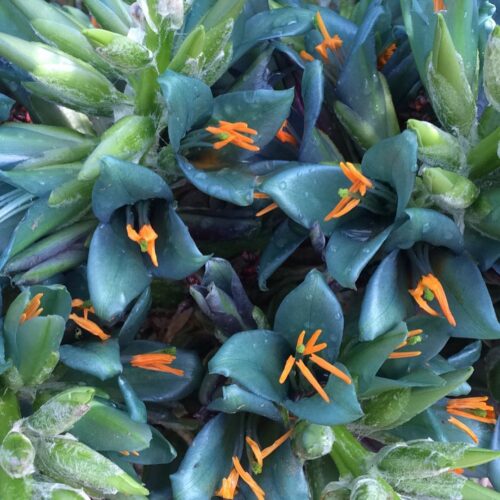Puya Alpestris is a beautiful succulent plant that features a rosette of deep green leaves and shiny, metallic, turquoise blooms.
Puya Alpestris is a lovely specimen that is loved for its attractive green leaves and turquoise flowers. You can grow this succulent both indoors and outdoors.
Common Names: Sapphire Tower, Mountain Puya
USDA Zones: 9a-11b
Read: How to Grow Echeveria Pulidonis
Puya Alpestris Information

Puya alpestris originates from south-central Chile. It thrives on dry slopes in the Andes. This plant is distinguished by clusters of rosettes displaying rich green foliage. These leaves are embellished with a thick layer of white scales underneath and feature gentle spines along the edges. They grow narrow and gracefully arch, reaching lengths of up to 2 feet (60 cm) and widths of about 1 inch (2.5 cm).
The flowers of Puya alpestris are quite interesting. They show off a shiny, metallic appearance and are a deep turquoise color with bright orange stamens. These flowers usually bloom in spring, but not every year. They grow on tall stalks; at the end of each stalk, there’s a long, bare branch with small pink leaves where birds can rest while they feed on nectar. The plant produces capsule-shaped fruits that contain many small seeds which can be carried by the wind. After the seeds are formed, the main part of the plant gradually dies.
Propagating Puya Alpestris
You can obtain Blue Puya seeds and grow the plants in a greenhouse. Puya seeds take a while to start growing and need temperatures of at least 70 degrees Fahrenheit (21 degrees Celsius). Use potting soil that drains well in a seed tray. Keep the soil moderately damp until the seeds start to sprout. When you notice the seedlings emerging, relocate the tray to a well-lit area, but shield them from the intense midday sunlight.
When the seedlings have grown into rosettes, you can move them to a larger pot. If you live in USDA zones 8 to 11, you can plant the rosettes in your garden, but you’ll need to bring them indoors during the winter if you’re in other zones. Blue Puya plants are excellent for patios until cold weather arrives.
Ideal Growing Conditions for Puya Alpestris
Location
Grow Puya Alpestris prefers sunny locations; make sure the plant receives 4-6 hours of light each day.
Soil
This plant grows well in well-draining soil blended with organic matter.
Water
During summer, water Puya plants in the ground once a week. For potted plants, water them when the top layer of soil has dried out. In winter, when the plant is dormant, water it only once a month.
Temperature and Humidity
The ideal temperature range for this plant lies between 55-75 F. It can tolerate temperatures as low as 25 F.
Puya Alpestris enjoys 40-60 percent humid surroundings. You can mist the plant to promote humidity.
Read: Adenia Perrieri: How to Grow Bottle Tree
Puya Alpestris Care
Fertilizer
Apply dilute succulent fertilizer or indoor plant fertilizer during spring according to the instructions on the package.
Pruning
For a tidy appearance, remove spent leaves from the rosettes.
Pests and Diseases
Pests such as aphids, mealybugs, spider mites, and scale insects can affect the plant.
You can prevent these pests by regularly checking plants for symptoms of infestation and treating infected ones with insecticidal soap solution or horticultural oil.
Root rot, leaf spot, and powdery mildew are diseases that can harm Puya Alpestris. To control these problems, the plant should be grown in well-draining soil and not overwatered.



